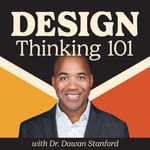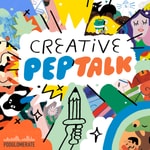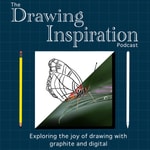Design Thinking 101 – Details, episodes & analysis
Podcast details
Technical and general information from the podcast's RSS feed.

Design Thinking 101
Dawan Stanford
Frequency: 1 episode/18d. Total Eps: 144

Recent rankings
Latest chart positions across Apple Podcasts and Spotify rankings.
Apple Podcasts
🇨🇦 Canada - design
28/07/2025#61🇨🇦 Canada - design
27/07/2025#46🇨🇦 Canada - design
26/07/2025#34🇩🇪 Germany - design
26/07/2025#96🇨🇦 Canada - design
25/07/2025#18🇩🇪 Germany - design
25/07/2025#92🇩🇪 Germany - design
24/07/2025#82🇩🇪 Germany - design
23/07/2025#64🇩🇪 Germany - design
22/07/2025#56🇩🇪 Germany - design
21/07/2025#37
Spotify
No recent rankings available
Shared links between episodes and podcasts
Links found in episode descriptions and other podcasts that share them.
See all- https://asana.com/
497 shares
- https://www.loom.com/
362 shares
- https://www.paypal.com/us/home
306 shares
RSS feed quality and score
Technical evaluation of the podcast's RSS feed quality and structure.
See allScore global : 53%
Publication history
Monthly episode publishing history over the past years.
Behavioral Science in Human-centered Design with Christina Hanschke — DT101 E139
Episode 139
mardi 3 septembre 2024 • Duration 01:01:23
Christina Hanschke's career journey has spanned many diverse roles. She's been a music therapist, nanny, and UX researcher, and she’s currently a Design Lead at Final Mile, where she applies a multidisciplinary approach to address pressing societal changes, drawing from behavioral science, human-centered design, and systems thinking. As an adjunct faculty at DePaul University, Christina extends her passion for leveraging behavioral science in human-centered design to the next generation of innovators fostering a diverse culture of curiosity and continual learning. Christina and I talk about behavioral science, design for global health, and the importance of learning design.
Listen to learn about:
>> Behavioral science in healthcare
>> Final Mile’s work in the global health space
>> Collaboration and co-creation with clients
>> Team facilitation
Our Guest
Christina's career journey, spanning diverse roles as a music therapist, nanny, and UX researcher, lays the groundwork for her current position as a Design Lead at Final Mile. Here, she applies a multidisciplinary approach to address pressing societal challenges, drawing from behavioral science, human-centered design, and systems thinking. She has had the privilege of collaborating with and supporting the efforts of community champions, local partners and ministries to address complex challenges such as HIV and vaccine hesitancy (COVID-19 and HPV).
Additionally, as an adjunct faculty at DePaul University, Christina extends her passion for leveraging behavioral science in human-centered design to the next generation of innovators, fostering a culture of curiosity and continual learning.
When she isn’t reading on the couch with her dogs, Christina finds joy in making music with friends.
Show Highlights
[02:38] Christina’s career started in music therapy, working with children, before becoming a nanny while going to graduate school at DePaul.
[03:44] Moving into UX research in business.
[04:01] Christina’s role at Final Mile.
[04:44] Working in the global health arena.
[05:27] Christina and her team’s work on vaccine hesitancy.
[08:38] Working with different countries and cultures.
[11:30] Dawan and Christina talk about handling power dynamics in their work.
[13:49] How Christina helps the people she’s working with to see value in the work.
[14:51] Using social learning and group work to encourage engagement and let them experience the value first-hand.
[17:54] Christina offers advice for facilitators.
[22:12] Behavioral science is understanding how people make decisions.
[22:33] The complicated behavioral challenges in the healthcare space.
[23:50] Understanding the “intent to action” gap.
[25:13] How starting a new project looks for Christina’s team.
[27:28] Co-creating and prototyping behavioral interventions with the people living the health issue.
[29:05] Using visualizations to quickly capture ideas and tell stories.
[31:36] Giving adults permission to be creative and curious.
[32:33] Christina asks Dawan about how he incorporates play into his work.
[34:29] Getting people to practice listening early on in an event or project.
[36:34] Other ways to get participants to connect and engage.
[39:32] Helping people get comfortable with discomfort.
[42:09] One thing Christina really enjoyed about working with teams in Kenya.
[46:30] There’s no single way to do design thinking.
[47:17] Christina’s experiences teaching graduate students about behavioral science and UX.
[50:21] Working with clients should be a collaborative relationship.
[52:25] Avoiding overcomplication of the process.
[56:27] Resources Christina recommends and that have helped her in her work.
[57:45] Last words from Christina on the importance of continual learning, and learning outside of your usual sphere.
Links
Christina on LinkedIn
Christina on ResearchGate
FinalMile Consulting
Improving Vaccine Uptake
Book Recommendations
Thinking, Fast and Slow, by Daniel Kahneman
Beyond Sticky Notes: Co-design for Real: Mindsets, methods and movements, by Kelly Ann McKercher
DT 101 Episodes
Talk to the Elephant: Design Learning for Behavior Change with Julie Dirksen — DT101 E131
Behavioral Design X Service Design with Anne van Lieren — DT101 E40
Behavioral Science + Behavior Change Design + Social Impact with Dustin DiTommaso — DT101 E28
Organizational Design + Strategy + Change with Stephanie Gioia — DT101 E138
Episode 138
mardi 25 juin 2024 • Duration 39:01
Stephanie Gioia is a founder at Future Work Design with a focus on strategic planning and organizational innovation. She also serves as the director of the Either/Org project and teaches human-centered design for organizational innovation at the University of Oregon's Executive MBA program. She’s taught at Stanford’s d.school, University of Michigan, and Pacific Northwest College of Art. She is the founder of deckaholic.com, the world's largest library of card decks for problem solving and creativity. We talk about organizational design and strategy, and helping organizations navigate change.
Listen to learn about:
>> Organizational design
>> Either/Org’s Inspiration Library for organizations
>> Prototyping organizational changes
>> Navigating and de-risking change
Our Guest
Stephanie Gioia (she/her) is a founding partner at Future Work Design with a focus on strategic planning and organizational innovation. Stephanie was one of the earliest strategists to use the power of Human Centered Design to solve organizational design challenges. Stephanie also serves as director of The Either/Org Project, an organizational design inspiration lab. This project vibrates all her interests: organization design, practical tool-making, learning and inspiration, and a firm belief that we can change the whole world by changing the world of work.
Stephanie teaches Human Centered Design for Organizational Innovation at University of Oregon’s Executive MBA program. In the past she has taught programs at Stanford’s d.school, University of Michigan, and Pacific Northwest College of Art. She is the founder of www.deckaholic.com, the world's largest library of card decks for problem solving and creativity.
Stephanie holds an MBA from the University of Michigan in Strategy and Organizational Sensemaking and earned her B.A. in History and Government from Georgetown University. She lives in beautiful Klickitat country (White Salmon, WA) with her partner Dave and is a mom to two fantastic kids.
Show Highlights
[01:59] Stephanie’s interest in organizational life led her to taking jobs in large organizations to see how they functioned.
[02:40] How can we make organizations operate better and be a better experience for employees?
[03:16] Getting an MBA in strategy and organizational sense making.
[03:52] Deciding to use design thinking to prototype and design better workplaces.
[04:55] Her time at IDEO.
[05:25] Co-founding Future Work Design.
[06:22] Working with clients at Future Work Design.
[07:54] Using Future Work Design’s Wayfinder card deck to help a team align and start working together.
[11:05] Helping clients get comfortable with ambiguity.
[11:23] Stephanie offers an example of a client project focused on reimagining how the client might make decisions better aligned with their core values.
[16:23] Reclaiming the “design” part of organizational design.
[20:18] The Either/Org’s inspiration library for organizations looking to innovate.
[22:57] Visualizing an organization beyond the org chart.
[23:57] Organizational prototyping.
[29:25] Helping organizations navigate and de-risk change.
[32:11] A project for an international NGP that entailed changing their entire operating model.
[34:07] Managing the expectations of change.
Links
Stephanie on LinkedIn
Stephanie on Medium
Stephanie on Instagram
Stephanie on YouTube
Stephanie on UX Magazine
Future Work Design
either/org
Deckaholic
DT 101 Episodes
Civic Design + Innovation Ops + System Design with Ryann Hoffman — DT101 E62
UX + Into, Through, and (Almost) Out of Design with Kara DeFrias — DT101 E103
Teaching and Applying Design Thinking in Higher Ed + The Experimentation Fieldbook with Liz Chen — E129
Episode 129
mardi 13 février 2024 • Duration 51:21
Liz Chen is Design Thinking Lead at Innovate Carolina, the unit dedicated to innovation, entrepreneurship, and economic development at The University of North Carolina at Chapel Hill. Liz is also a co-author of The Experimentation Field Book, a practical how-to guide on rigorously testing assumptions and concepts. We talk about teaching and applying design thinking in higher education, and learn more about The Experimentation Field Book.
Listen to learn about:
>> Innovate Carolina
>> The Experimentation Field Book
>> Design thinking and public health
>> Design thinking in strategic planning
Our Guest
Liz is Design Thinking Lead at Innovate Carolina, the unit dedicated to innovation, entrepreneurship, and economic development at The University of North Carolina at Chapel Hill. She leads the interdisciplinary Graduate Certificate in Innovation for the Public Good and launched her team’s recharge center that allows grad student Design Thinking and Innovation Fellows to work on staff as part-time employees to support design and innovation projects with clients inside and outside of the university. Liz is also a co-author of The Experimentation Field Book, a practical how-to guide on rigorously testing assumptions and concepts. Liz is a former high school science teacher, tech nonprofit co-founder, and public health researcher.
Show Highlights
[02:50] Getting accepted into Innovation Next as a grad student, a national innovation acceleration program.
[03:30] Completing her Ph.D. and becoming the Design Thinking Lead at Innovate Carolina.
[04:16] The changes Liz has seen in how design thinking is being used in research.
[04:54] Liz talks about a project funded by the EPA that she and her student team are working on, to reduce food waste.
[06:34] UNC’s graduate certificate program in Innovation for the Public Good.
[07:24] Divergent vs. convergent thinking.
[08:41] The challenges in using design thinking when many funding organizations ask you to pitch a “single solution.”
[11:15] Sharing what didn’t work is as important as sharing what did work.
[12:24] Innovate Carolina has consulting services, where grad students and fellows get to work on client projects.
[15:43] Liz talks about how Innovate Carolina’s infrastructure works within the infrastructure of the university.
[19:15] The Experimentation Field Book provides resources for readers to self-teach the process of testing ideas and assumptions.
[20:59] A Miro Moment.
[23:35] Some of Liz’s favorite tools from the book.
[25:45] The book’s five-step testing process.
[28:17] Using design thinking in public health.
[33:56] Three things Liz wishes people knew about teaching science at the high school level.
[39:29] The Experimentation Field Book is for anyone who is problem-solving or innovating.
[42:11] Liz and her team are helping with the work on UNC’s Carolina Next strategic plan.
45:51] Dawan shares a little about his strategy design experiences at Ohio State University.
Links
Liz on LinkedIn
Liz on UNC’s website
Liz on ResearchGate
Liz on GoogleScholar
Innovate Carolina
Carolina Graduate Certificate in Innovation for the Public Good
MyHealthEd
Want 20% off of The Experimentation Field Book? Click here and use promo code CUP20
Other Design Thinking 101 Episodes You Might Like
The Experimentation Field Book with Natalie Foley — DT101 E123
Experiencing Design: The Innovator’s Journey with Karen Hold — DT101 E71
Designing Facilitation: A System for Creating and Leading Exceptional Events // ALD 006 — DT101 E73
The Evolution of Teaching and Learning Design with Bruce Hanington — DT101 E39
mardi 18 février 2020 • Duration 42:49
Welcome to the Design Thinking 101 podcast! I'm Dawan Stanford, your host. In today's episode I am joined by Bruce Hanington. He remembers being introduced to design as a small child with his father being a Commercial Designer. Initially headed for a career in architecture, his journey took a detour as an undergrad when he ended up graduating with a degree in Applied Psychology. But Bruce realized he wanted to get into design, and that he wanted to be on the creative side instead of just studying design. During his graduate work in industrial design, he continued his interest in dealing with the more human factors of design, primarily, how design affects everyday encounters and life.
After emerging with an Industrial Design education coupled with Applied Psychology, he landed in academia in the School of Design as a part of the Industrial Design core, able to teach in all the aspects of teaching he loves best, including form giving, human factors, and understanding the interpretation of objects with meaning and significance. His recent promotions included an appointment to the Head of Design at Carnegie Mellon six months ago.
Bruce believes technology, and the products which are a part of our life now as a direct result of technology, are the biggest game-changers for design thinking. The orientation of work toward social causes, and designing for social good, has become an established part of design thinking.
On disciplinary boundaries, “I think you see a broadening of boundaries so regardless of what form of design you may have a particular passion for and how you might study it, ultimately I think that designers have a more broad-based understanding of design and problem solving in general, and design methods, approaches and practices can be applied to almost any design.”
Bruce has seen a shift in design methods over time, especially in the surge of information via books and online courses. He recently authored his own book on design thinking, “Universal Methods of Design.” There’s been a shift in design thinking to design responsibly for everyday living to enhance people’s lives.
Listen in to find out the new hurdles of design thinking, what new companies are looking for concerning the design thinking process, and why design thinking is more of a philosophical approach. Find out Bruce’s opinion on which methods or approaches to design have changed the most in the past decade.
Our Guest
Bruce Hanington is a professor and head of the School of Design at Carnegie Mellon University in Pittsburgh, Pennsylvania. Prior to this, he was director of graduate studies, and program chair of industrial design. Bruce has dedicated his teaching and research to methods and practices for human-centered design, with an emphasis on design ethnography, participatory design, and the meaning of form in context.
In addition to working with industry partners through collaborative projects and executive education, his work has been published in Design Issues, The Design Journal, and Interactions, with chapters in Affective Sciences in Human Factors and Human-Computer Interaction, and The Routledge Handbook of Sustainable Design. Bruce is co-author of the book Universal Methods of Design: 100 Ways to Research Complex Problems, Develop Innovative Ideas, and Design Effective Solutions.
In This Episode
[01:06] How Bruce arrived to where he is today.
[05:32] Bruce’s recent promotions in the design field.
[06:35] Factors which Bruce believes are having a significant impact on design in the classroom.
[08:45] Components which are a factor of design maturing in the United States.
[10:21] How Bruce has seen design research methods shift over time.
[13:34] Wrestling with the “rush to artifact.”
[16:48] Companies are looking for ways to design more creatively, flexibly, and collaboratively.
[18:45] Challenges brought to the design thinking table, and responses that work well.
[23:11] Changes and updates that Bruce has recognized in the newest edition of his book.
[28:20] Where students are headed in the future, and what will they need to be equipped with to succeed in design thinking.
[35:38] What needs to happen at the personal level for students and professors.
[38:52] How you can contact Bruce and learn more about his work.
Links and Resources
Bruce Hanington on LinkedIn
Bruce Hanington on the Web
Bruce Hanington at CMU
Bruce Hanington's Research
Bruce Hanington's articles on Academia.edu
Design Research Methods: a Repository of Research Methods for Design
An interview with Bruce Hanington on Medium
Design for America
Elon By Design at Elon University
Center for Design Thinking at Elon University
Book Recommendations
Universal Methods of Design: 100 Ways to Research Complex Problems
Develop Innovative Ideas, and Design Effective Solutions by Hanington, Bruce & Martin, Bella
The Pocket Universal Methods of Design by Hanington, Bruce & Martin, Bella
Nursing + Service Design + Healthcare Innovation with Brittany Merkle — DT101 E38
mardi 4 février 2020 • Duration 34:39
Welcome to the Design Thinking 101 podcast! I'm Dawan Stanford, your host. Today's
Guest is Brittany Merkle. Her design path started at the University of Virginia in the College of Arts and Sciences. During her first semester, her grandfather was diagnosed with cancer. On weekend trips home, Brittany witnessed the incredible service Hospice offered. When she returned for her second year at college, she immediately changed majors and enrolled in nursing. Brittany shadowed nursing students and learned what nursing looked like as a career.
She jumped into qualitative research and realized she wanted her career to combine two things: 1. Creativity, and 2. Make a difference. "These two seemed very siloed in my mind," Brittany remarked. She hadn’t yet considered fusing these two aspects into one career.
Brittany wasn't sure where she wanted to go for graduate school, when she came across the Savannah College of Art and Design. She started with Hospice Case Management, but continued to think of service design in relation to her profession. Brittany enrolled in the SCAD Master's program and started to unlearn her previous content she learned from her Bachelor’s degree, which was her biggest challenge. She was one of the first nurses to graduate from the SCAD program.
She was looking for a new approach to bring to the healthcare system, which she found as a lead innovation strategist with the University's healthcare team. Brittany wanted to make her mark in the system and to challenge herself with the design skills she has learned.
Our Guest
Brittany Merkle, RN, BSN, supports the innovation and design thinking efforts in UH Ventures. She graduated from the University of Virginia with a Bachelor of Science in Nursing with distinction, and is graduating from the Savannah College of Art and Design (SCAD) with a Master of Fine Arts in Service Design.
She is one of the first nurses to graduate from SCAD, and the first in the country with this specific degree combination. She has experience in Hospice Case Management, and in acute and urgent care services as a practicing Registered Nurse before she began pursuing her Master's. Her thesis focused on service design as a lens for nursing innovation.
Brittany is passionate about the demystification of innovation and catalyzing innovative behavior amongst healthcare providers and caregivers. Her work is focused on enhancing patient and provider experiences through innovative care models and digital tools.
In This Episode
[01:13] Brittany’s background and path to design thinking.
[03:40] Her realization of what she wanted to do with her career.
[06:39] The turning point for Brittany, where her learning became her unlearning.
[08:44] How SCAD spoke to Brittany’s imposter syndrome.
[10:45] Brittany’s design internship.
[12:14] UH’s prototypical healthcare system.
[16:27] New design language Brittany is adapting to her new position.
[17:18] Unique superpowers when she is performing her fieldwork.
[19:33] Advice Brittany would give to other healthcare professionals who do not have a design background.
[27:49] Suggestions for faculty on the innovation side of healthcare.
[30:27] Resources that have helped Brittany along the way.
Links and Resources
SCAD | Savannah College of Art & Design Service Design Program
UH Ventures
Brittany Merkle on LinkedIn
Dustin DiTommaso’s podcast episode Episode 28, Behavior Change Design
Book Recommendations
This is Service Design Doing by Marc Stickdorn
The Alchemist by Paulo Coelho
On Managing Yourself by Harvard Business Review
Design for America: Founding + Present + Future, Part 2 — DT101 E37
mardi 17 décembre 2019 • Duration 35:17
Welcome to the Design Thinking 101 podcast! I'm Dawan Stanford, your host. Today's episode is part two of a two-part series on Design for America. Design for America is a nationwide network that supports design innovation for social impact. DFA was founded at Northwestern University, and is helping to shape the next generation of social innovators and student-led design-led studios on over 40 college campuses. Today, we'll speak to two guests about what Design for America is, why DFA exists, how DFA works, and what the future may look like at Design for America.
We start our episode talking to Kelly Wisneski about her DFA experience, which began at Washington University in St. Louis during her undergraduate education. She knew she wanted to talk to people who were involved in Design For America in the Washington University chapter. She was working on a project related to food insecurity in St. Louis when she realized DFA would be her entry point into St. Louis. Kelly joined DFA during her first semester at university, and found herself on the leadership board in her second semester.
She enjoyed being part of the leadership board and having a hand in growing DFA from a small studio into a more extensive workshop. Kelly assisted others in getting their projects off the ground in her early stages of leadership. In 2019, Kelly has contributed to the building of nine new DFA studios. "DFA is not just design thinking projects, they are projects that are here to make an impact on the people that it matters to the most."
Our second conversation is with Liz Gerber. We first chatted with Liz about how DFA was launched. She worked in the research sector of the toy industry with kids, asking them how they would build their own toys. As a new professor at her university, Liz was not satisfied with just research and publishing. She wanted to launch a new idea that she had brewing. Liz yearned to create a unique educational and impact structure in which students were working directly with community members. She broke down the boundary between the classroom and campus and the “real world,” giving students the ability to tackle and solve real-world community problems.
Our Guests
Kelly Wisneski is a Program Coordinator at Design for America, supporting DFA studios across the country and working to improve DFA's data systems. She graduated from Washington University in St. Louis, where she studied Architecture and Computer Science and led her local DFA chapter for 4 years.
Liz Gerber is the Faculty Director and Co-Founder at Design for America. The question that drives her is, "What can I do for others," and she continues to create communities that innovate collectively to tackle messy and meaningful problems. She is a design professor with a passion for understanding social interactions and practical applications for the technology.
In This Episode
[01:34] Kelly talks about her early DFA experiences.
[04:25] Advice Kelly gives for studios that are getting off the ground.
[07:27] What Kelly has learned and what her students have learned when they are a part of the project experience.
[10:57] Kelly highlights some DFA project components she enjoyed learning.
[11:57] How Kelly is working with mentors and guiding them through the process.
[15:08] Kelly’s advice if you want to start a DFA studio.
[16:37] Liz tells the DFA launch backstory.
[20:30] The students’ first challenge: helping children with diabetes.
[22:15] Ten years later: Liz reflects on the work of DFA.
[23:40] Anniversary party for DFA and the DFA chapter’s ripple effects.
[29:13] Open questions about the future for DFA.
Links and Resources:
Liz Gerber at Northwestern University
Liz Gerber on LinkedIn
Kelly Wisneski on LinkedIn
UC San Diego Design Lab
Contact UC San Diego Design Lab
Design for America
Northwestern University
Elon By Design at Elon University
Center for Design Thinking at Elon University
Design for America Washington University
DFA Receives Cooper Hewitt Design Award in 2018
Design for America: Students + Design Thinking + Community Impact, Part 1 — DT101 E36
jeudi 12 décembre 2019 • Duration 42:01
Welcome to the Design Thinking 101 podcast! I'm Dawan Stanford, your host. Today's episode is part one of a two-part series on Design for America. Design for America is a nationwide network that supports innovation for social impact. DFA was founded at Northwestern University, and is helping to shape the next generation of social innovators and design-led studios on over 40 college campuses. Today, we’ll speak to three guests about what Design for America is and what does the experience look like when a member participates in a Design for America studio.
We start our episode with Eric Richards explaining how he founded Design for America on the UC San Diego campus. Eric was interested in human-led design and, coupled with his interest in social impact, Eric started to search Facebook for others who had a similar desire in utilizing both fields interchangeably. He found a Good Design Lab founded by Don Mormont at UC San Diego. Many of the UC San Diego students who were interested in human-led design had worked at this lab. Eric liked the concept, applied to the university, and was accepted to the program.
Through this lab and Don's involvement, many design classes were available to students. Eric joined Good Design Lab as a sophomore - the year after the lab was founded - and took the introductory design class. During his journey with Good Design Lab, Eric became part of a very tight-knit community. He was grateful to have found a community that, like Eric, valued using their skill set for social impact.
Andrew Demas discovered DFA by accident while he was a student. He had a friend who was involved in DFA, and one day Andrew visited the Good Design Lab. He fell in love with the process and how the process affects social impact. DFA taught Andrew how to find out who your user is, gaining empathy for the user, and developing a solution for someone else. His new perspective not only changed the way he solved problems in real-world applications, it also changed his view of how he thinks about his curriculum at school, and changed the way he works towards coming up with solutions.
Throughout this time, Andrew was connected to many other students who had a passion for design and for giving back to their community in a sustainable way. He was able to put his newfound skills to use when he and his classmates rebuilt a community center that was destroyed by Hurricane Sandy. Andrew felt that DFA gave him his best college and learning experience in university, and he’s passionate about his alumni board and networking for future leaders of design thinking and to get more corporations involved with DFA.
William Moner is a faculty member who sponsors a DFA Studio at Elon University. Dawan Stanford approached William to mentor and encourage students to engage in the design process. William talks about the process of creating a DFA Studio, using DFA guides, and bringing together the efforts of everyone involved to make DFA happen on campus. He also discusses the challenges of mentoring and recruiting students for DFA.
Our Guests
Eric Richards is starting his last year at UC San Diego, where he's studying Human-Computer Interaction and Design for Social Innovation. His interest is in design that empowers communities and advances equity and sustainability. He currently leads Design for America at UCSD, and advises undergraduate humanitarian engineering projects on campus.
Andrew Demas is a Senior Managing Consultant in IBM's Digital Strategy & IX practice and is also the digital account partner for one of IBM's top telecommunications clients. As an IBM Design Thinking Leader, he runs the New York Design Thinking Chapter. His passion for design started with DFA; he served as President of the Barnard-Columbia Design for America Studio for three years, and he currently sits on the DFA Alumni Board.
William Moner is an Assistant Professor of Communication at Elon University and is the faculty mentor for the Elon Design for America studio. He holds a Ph.D. in Radio-Television-Film from the University of Texas, and his research focuses on emerging methods of storytelling and interactive media production through open software platforms and systems.
In This Episode
[01:28] Eric tells his story of how he founded Design for America at UCSD.
[02:54] Eric’s early experience with DFA chapter on campus.
[05:15] How Eric foresees using his skills in his work in the future.
[06:31] How Eric came into and is currently developing his need-finding skills.
[09:09] The value Eric finds in DFA and his DFA experience.
[13:40] Andrew’s transformative experience with DFA on his university campus.
[15:43] Andrew’s most memorable project to date, and the skills Andrew and his classmates employed to this project, and what he learned from DFA.
[20:03] Andrew and his passion project with DFA.
[26:44] Students start to bring DFA to Elon University.
[32:30] Wicked problems in the DFA Studio at Elon University.
[34:28] William’s advice on how to mentor at a DFA Studio.
[38:58] The work of DFA and who William is grateful for at DFA.
Links and Resources
UC San Diego Design Lab
Contact UC San Diego Design Lab
Design for America
Elon By Design at Elon University
Center for Design Thinking at Elon University
Bernard-Columbia Design for America
William Moner
Andrew Demas
Eric Richards
Integrating Engineering, Design and Business with Tony Hu — DT101 E35
mardi 26 novembre 2019 • Duration 42:13
Welcome to the Design Thinking 101 podcast! I'm Dawan Stanford, your host. Today I'll be interviewing Tony Hu, who is the academic director at MIT’s Integrated Design and Management Master’s program. We’ll be talking about how Tony discovered design, human-centered design’s impact on students, and MIT’s unique program combining design and engineering management.
We start our episode during Tony’s high school career, with his passion for writing. He started on the journalism team and edited the school newspaper. Additionally, he was interested in gadgets - this was during the Sony Walkman era. Tony was interested in working on a similar technology at the time. His father was an engineer and was a big influence on Tony’s career. He heard MIT was the route to take if he was serious about engineering, so he applied and was accepted, to the dismay of his journalism teacher.
While at MIT, Tony studied transistors and Maxwell’s equations, which was not an enjoyable experience for him. He stuck through the course and found an interesting opportunity with an internship from the media lab working with the “newspaper of the future.” He graduated with an electrical engineering degree; however, he wasn’t actually interested in the field. Tony wanted to learn about other aspects of products and interviewed with IBM in Boston as a Systems Engineer. When he started getting bored selling computers, he decided to look into a career in advertising. He was pursuing a bookstore for advertising books when just a few shelves down he discovered books on industrial design and product design. He found out about night classes at a local college and was hooked! After talking with several people, he found out about the Stanford program and fell in love with Stanford.
Tony talks about the challenges he faced in the early 1980s in the industrial design career. He realizes that students today are challenged with finding multiple solutions instead of just one engineering solution. Students are having to change their mindset and thinking, to offer numerous solutions. Another challenge is interviewing others, especially when they themselves are an introvert.
During his journey, Tony has designed toys and been a consultant to numerous companies. He was the first designer and product developer at a small company that sold baby products. At this first position, he learned the value of testing products. He then went through a succession of companies, exploring his passion for working with toys. His primary interest was to see a product all the way through from design to marketing, and he still wanted to stay in the toy field.
He started his own company creating toys and licensing them out to companies. One of his crazier designs was a bodysuit with casters which you could use to roll down a road! Another design he created was breathable, more comfortable protective gear for rollerblading.
Throughout this time, Tony taught Visual Design at Stanford. He met his wife, and 13 years later when she was expecting her first child and needed to find a teacher for her classes, she suggested her husband for the position. He ended up teaching several of her classes. Through his wife and teaching, he met Matt Kressy, who is an industrial designer from the Rhode Island School of Design. Matt went on to start a design program at MIT and invited Tony to check it out. A few years later, Matt asked him to join the program.
Our Guest
Tony Hu is the Academic Director of MIT's Integrated Design & Management Master's Program. As an entrepreneurial leader with 20+ years of experience as head of product development at both startups and large corporations, he has brought over 200 consumer products to market globally, including electronics, appliances, toys, and sporting goods, and is a champion of design, creativity, and innovation. He’s also an inventor, with 18 patents and 22 products he designed and licensed himself.
For the past 13 years, Tony has taught design thinking as a lecturer at MIT and Stanford. He earned his Masters in Product Design at Stanford and his bachelor in Electrical Engineering at MIT, where he conducted research at the Media Lab. As a teacher, he is a rarity: an engineer with a background in both design and business. Tony loves sharing his holistic approach to product design with students.
In This Episode
[01:05] Tony talks about his origin story in design and how he started on the path to design.
[05:07] How he landed a job at IBM and his experience at IBM in sales.
[07:01] Tony’s introduction into industrial and product design.
[08:30] Challenges Tony encountered in the early years of working in design.
[11:58] Tony talks about his first product development position and his takeaways from product development.
[16:04] Tony’s steps further down his design journey, focusing mainly on toys.
[20:18] Before the .com boom - more history and working with different companies.
[25:05] Tony talks about meeting Matt and how working with Matt influenced Tony’s path in design.
[27:28] How this unique program is attracting diverse learners.
[30:02] The process of design thinking on product development.
[35:33] Tony’s role in the transformation of teaching design thinking.
[39:08] Find out about Tony’s newest endeavor: Brainy Yak Labs
Links and Resources
Teaching and Learning Service Design for Designers and Non-designers with Maurício Manhães — DT101 E34
mardi 5 novembre 2019 • Duration 45:55
Welcome to the Design Thinking 101 podcast! I'm Dawan Stanford, your host. Today I'll be interviewing Maurício Manhães and talking about his design position at Savannah College of Art and Design, his work at the Service Design Network and as the group leader at the Design Academic Task Force.
In this episode, we talk about the crisis that caused Maurício to shift into service design, how service designers are learning their craft, and his work to create service design curriculum for non-designers.
We’ll explore Maurício's 15-year background in IT and marketing, and his reaction to having a failed project. He couldn't figure out why his project was received poorly by his client until he discovered that he didn't understand the people he was designing for. This was when he found design thinking.
Maurício was intrigued by how service design was based on a complex and systemic approach to social technical design. Through this revelation, he understood his approach to design and problem-solving was flawed. At this point, he decided to return to school. He received a Master's Degree in Knowledge Management, and then a Ph.D, and he then started teaching service design at the Savannah College of Art and Design (SCAD).
Since Maurício joined SCAD, their program has gained over two dozen students, making their program one of the largest in the world. Students come with curious minds, wanting to know how they can involve stakeholders in the design process and have a better perspective on the social technical design context.
Maurício talks about how he and his department at SCAD are adding new courses pertaining to design to enhance the degree, including how innovation is understood in an adaptive system. The program is very demanding, resulting in two-thirds of the program's students being hired one year before they graduate.
This episode also offers a look at providing the perspective of the complex and active systems of design thinking to non-designers. Maurício explains how he conveys this complex concept to creators without a design background. He also delves into the ethics of service design, the illusion of being able to change a person’s behavior, and common issues first year designers have when they start their career.
Our Guest
Maurício Manhães is a Professor of Service Design at the Savannah College of Art and Design and an Associate Design Researcher at Livework and the group leader of the Service Design Network Academic Task Force. In 2015, he obtained a Doctoral degree in Knowledge Management with a focus on service innovation at the Federal University of Santa Catarina in Brazil in partnership with the Koeln International School of Design in Germany with the thesis "Innovativeness and Prejudice: Designing a Landscape of Diversity for Knowledge Creation." In addition to his professorship, he works on consultancy projects and conducts workshops, courses, and lectures on design, design research, and service innovation worldwide.
In This Episode
[01:10] Maurício’s journey from IT project management into design thinking.
[04:50] He gives background on SCAD department and his role in this department.
[06:54] SCAD department and how their cohort has grown.
[11:16] Curriculum changes to the complexity of the design program at SCAD.
[12:34] Maurício talks about why they are adding complex adaptive systems to the curriculum at SCAD.
[14:09] Two-thirds of students are hired one year before graduation.
[16:06] How service design theory and service design logic prepares students for design at high levels.
[17:53] How Maurício is bridging the gap between learning service design and the perspective of the complex and active systems of design thinking.
[22:24] Teaching service design to non-designers.
[27:02] Ethics of service design and how they play out among non-designers.
[38:13] Common threads on challenges that are faced by first year designers.
[40:41] The early days of design thinking.
Links and Resources
Maurício on Twitter
Savannah College of Art and Design
Maurício on LinkedIn
Maurício on the Service Design Network
Maurício’s presentation on the Three Overarching Perspectives for Service Design at SDGC18, and the presentation slide deck: Three Overarching Perspectives for Service Design
Interview with Mauricio on the Design Decode website
Humble Design Leadership + Design Agency and Experience Design Evolution with Aleksandra Melnikova — DT101 E33
mardi 22 octobre 2019 • Duration 01:04:00
[05:04] She describes the team she leads as Head of Experience Design at Publicis•Poke in London.
[05:25] How Aleksandra brings out the best in her team, which has a wide array of talents.
[06:58] Aleksandra coaches humility with her team, based on the ever-changing world and the lack of knowledge we have because our world changes so fast.
[08:56] How Aleksandra assists clients in adapting to this process of questioning when they are working together.
[10:50] Tuning the relationship with the client when they haven’t worked with a team who uses design thinking.
[13:06] How blurring the boundaries on design affects the work being done by her team.
[15:03] Is there a shift in approach to experience design?
[18:54] The five why questions Aleksandra uses when having conversations with her clients.
[20:08] Viewing your project from the protagonist’s viewpoint is helpful with design thinking.
[22:14] Elements and engagements that is making Aleksandra’s work possible.
[24:09] How Aleksandra uses simple interviews and other elements to create valuable data for her clients.
[26:45] The value of the journey in the process of design thinking and how Aleksandra is against selling deliverables.
[30:41] Where can you find innovation in design thinking.
[35:47] Advice Aleksandra gives to emerging designers.
[40:08] The ethical role expanding and emerging in the design process.
[44:17] Thinking about the future and what is the worst thing that can happen if you say “no” to an idea or action.
[50:57] Use of technology and how technology can impact work.
[52:21] Don’t get too focused on the mono tools or methods and using them for every project.
[55:46] “Best practice” means “stop thinking."
[57:34] Looking forward to what can lead to transformation. Links and Resources Design for the Real World by Victor Papanek
Ruined by Design by Mike Monteiro
Aleksandra Meinikova on Medium
Aleksandra on Twitter
Aleksandra on the Web
Find Aleksandra on LinkedIn
Aleksandra at Women Talk Design
Publicis•Poke









